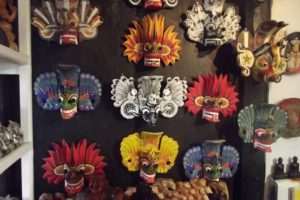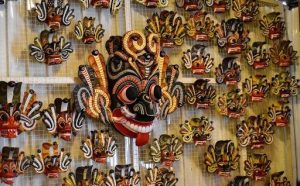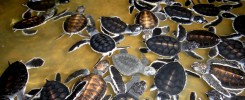Ambalangoda Mask Museum
Nestled in the heart of Ambalangoda, along the enchanting Main Street, lies a cultural treasure trove that beckons travelers and connoisseurs of artistry – the Ambalangoda Mask Museum. This captivating sanctuary pays homage to the illustrious tradition of crafting traditional Sri Lankan masks, a heritage as old as time itself, where every mask is a testament to the meticulous hands that carve and paint them with love and precision.
In the rhythmic tapestry of southern dance forms, such as the mesmerizing Kolam masked dance/drama, the graceful Kandyan performances, and the vibrant Sabaragamu dances, masks are the living embodiments of storytelling and artistic expression. In the heart of this artistic haven stands the Ariyapala & Sons Mask Museum, a sanctuary that cradles a comprehensive collection of masks, and offers an intimate glimpse into the very cradle of their creation in an adjoining workshop.
The Significance of the Ambalangoda Mask Museum transcends mere display; it serves as an ambassador of cultural heritage, inviting curious souls to embark on a journey deep into the soul of Sri Lankan society. This museum is not a relic of the past but a living testament to the enduring legacy of these magnificent masks, their stories etched into every brushstroke and chisel mark. It stands as a guardian, entrusted with preserving an art form that transcends generations.
Amidst the coastal embrace of Ambalangoda, a town adorned with tales of mask-making mastery, the Karava people, guardians of this tradition, have etched their mark in history. Masks, more than mere adornments, play an integral role in the rich tapestry of performances and rituals that breathe life into the town’s cultural heritage. The Kolam Maduwa Performance, with its spirited mask-wearing dancers, is an embodiment of this tradition, a spirited dance form that tells tales of yore.
But the story is not just one of vibrant performances; it is a tale of rituals and healing, of exorcising malevolent demons that threaten the harmony of existence. These masks, created with reverence and care, hold a deeper purpose as they are wielded in the sacred dance of exorcism, safeguarding against afflictions and diseases.
The evolution of time has brought economic factors to the forefront, impacting the frequency and popularity of these age-old performances. The decline of the Kolam Dances is but a reflection of changing times and shifting entertainment preferences. Yet, the spirit of tradition lives on, albeit in a different form, as mask carving has metamorphosed into a cottage industry, offering a lifeline to this cherished legacy.
 In the pursuit of preservation, the Wijesooriya family has embarked on an extraordinary endeavor, carving a complete set of 120 masks that encapsulate the intricacies and exquisite beauty of traditional mask artistry. While space constraints prevent the exhibition of all these masterpieces, the museum proudly showcases two distinct sets – one hailing from the Kolam Maduwa and the other, donned during the Sanni Yakuma ritual in Batapola and Ambalangoda, in the years 1985 and 1986.
In the pursuit of preservation, the Wijesooriya family has embarked on an extraordinary endeavor, carving a complete set of 120 masks that encapsulate the intricacies and exquisite beauty of traditional mask artistry. While space constraints prevent the exhibition of all these masterpieces, the museum proudly showcases two distinct sets – one hailing from the Kolam Maduwa and the other, donned during the Sanni Yakuma ritual in Batapola and Ambalangoda, in the years 1985 and 1986.
Step inside the Ambalangoda Mask Museum, and you will be greeted by an enchanting world of masks that transport you to the heart of Sri Lankan culture and folklore. These masks are not just inanimate objects; they are the embodiments of stories, emotions, and age-old wisdom.
Among the captivating masks you will encounter are the Raksha Masks, resplendent with their exotic and menacing allure. These masks, often adorned with intricate designs and vivid colors, depict demons with bulging eyes, bloodthirsty expressions, and protruding tongues. They are more than mere works of art; they are gateways to the supernatural, each with a unique narrative:
- The Cobra Raksha, a symbol of dominion over foes, capturing them as slaves.
- The Naga Raksha, a multi-headed serpent, the protector of captives.
- The Gurulu Raksha, an embodiment of rescue, represented by a hawk or eagle.
- The Maru Raksha, a majestic peacock, a harbinger of peace and prosperity.
- The Mayura Raksha, with healing powers to cure ailments.
- The Gara Raksha, fiercely guarding against malevolent spirits.
- The Ginidal Raksha, projecting anger and safeguarding against evil forces.
In the world of masks, Kolam Masks hold a special place, their origins traced back to the colonial era. These masks, with their fixed stares, bulging eyes, and eerie grins, exude an enigmatic aura. Yet, they are steeped in tradition and cultural commentary:
- The Anabera Kolama, a comedic character adding humor to performances.
- The Nonchi Akka Kolama, portraying the wife of an official drummer.
- The Jeydi Vidane or Rada Kolama, embodying comedic elements.
- The Jasa Kolama, bringing village chief comedy to the forefront.
- The Arachchi Kolama, showcasing soldier-centric humor.
- The Hewa Kolama, adding humor through character portrayal.
- The Lenchina Kolama, portraying the humorous side of grandparents.
- The Aththa Muththa Kolama, representing diversity with Negro characters.
- The Kapiri Kolama, contributing cultural diversity and social commentary.
- The Marakkala Kolama, embodying Tamil comedy and culture.
- The Demala Kolama, delivering entertainment through royal narratives.
- The Raja Kolama, a symbol of elegance and grace.
- The Panchanarigathya Kolama, evoking mystique and enchantment.
- The Deva Giri Kolama, symbolizing love, attraction, and desire.
The Sanni Masks are not just works of art but tools for healing, each embodying a specific ailment. These masks are essential in exorcism rituals aimed at treating diseases and afflictions:
- The Deva Sanniya, protecting against diseases like measles and cholera.
- The Vatha Sanniya, seeking relief from ailments related to air in the body.
- The Ginijala Sanniya, associated with diseases related to bile and heat.
- The Pith Sanniya, providing solace from stomach-related ailments.
- The Amukku Sanniya, offering healing for those rendered mute.
- The Abhutha Sanniya, associated with supernatural diseases.
- The Naga Sanniya, protecting against snakebite-related afflictions.
- The Murthu Sanniya, warding off witchcraft and malevolent forces.
- The Demala Sanniya, addressing diseases of the head and brain.
- The Kora Sanniya, aiding mental health and psychiatric well-being.
- The Golu Sanniya, guarding against evil forces with a fierce presence.
- The Butha Sanniya, offering protection from elemental forces.
- The Kana Sanniya, addressing eye diseases and visual impairments.
- The Jala Sanniya, seeking protection from water-related illnesses.
- The Bihiri Sanniya, offering relief from deafness and hearing impairments.
- The Vedi Sanniya, safeguarding against insect-borne diseases.
- The Maru Sanniya, addressing fever, heat, and sun-related afflictions.
- The Gulma Sanniya, offering solace from tumors and growth-related ailments.
The Ambalangoda Mask Museum is not just a repository of art but a sanctuary where stories come to life, where history is carved in every mask, where culture breathes through every stroke of paint. It stands as a testament to the vibrant heritage of Ambalangoda, where masks are more than just adornments; they are the living embodiments of tradition, a legacy to be cherished and celebrated for generations to come.
Embark on a journey to the Ambalangoda Mask Museum, where Sri Lankan masks whisper tales of yore, where culture and art merge in a symphony of colors and shapes, and where tradition finds its eternal sanctuary.


